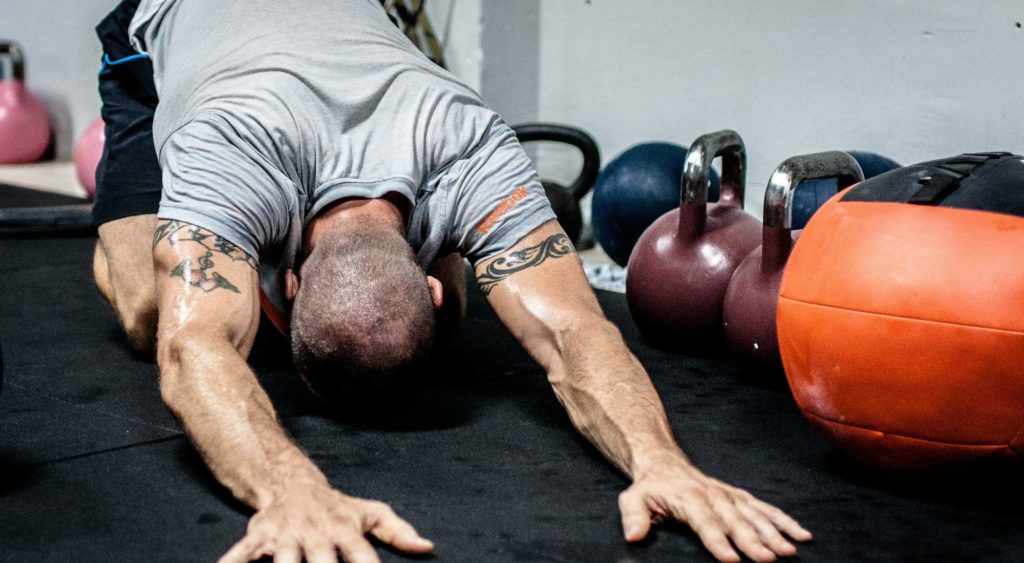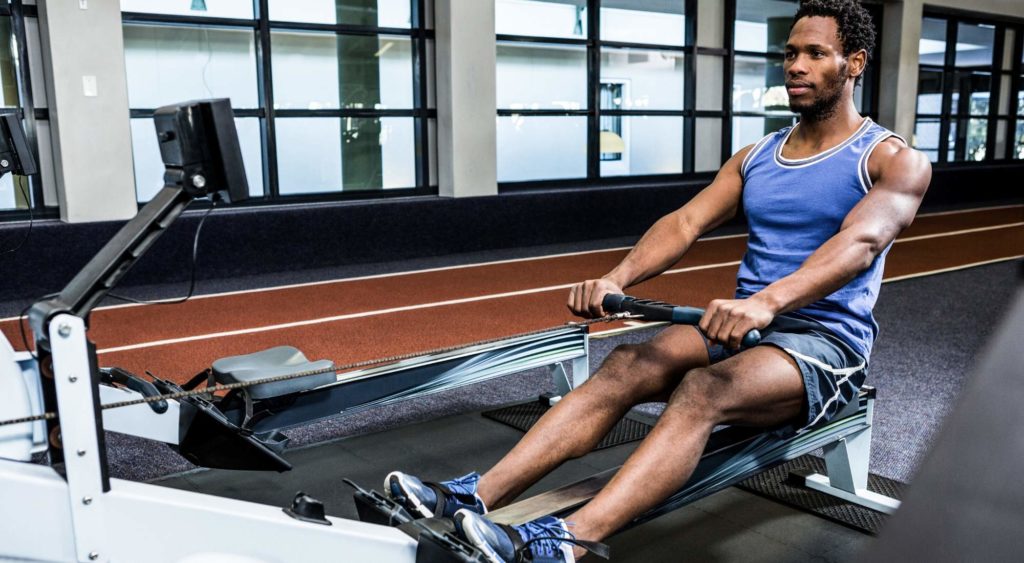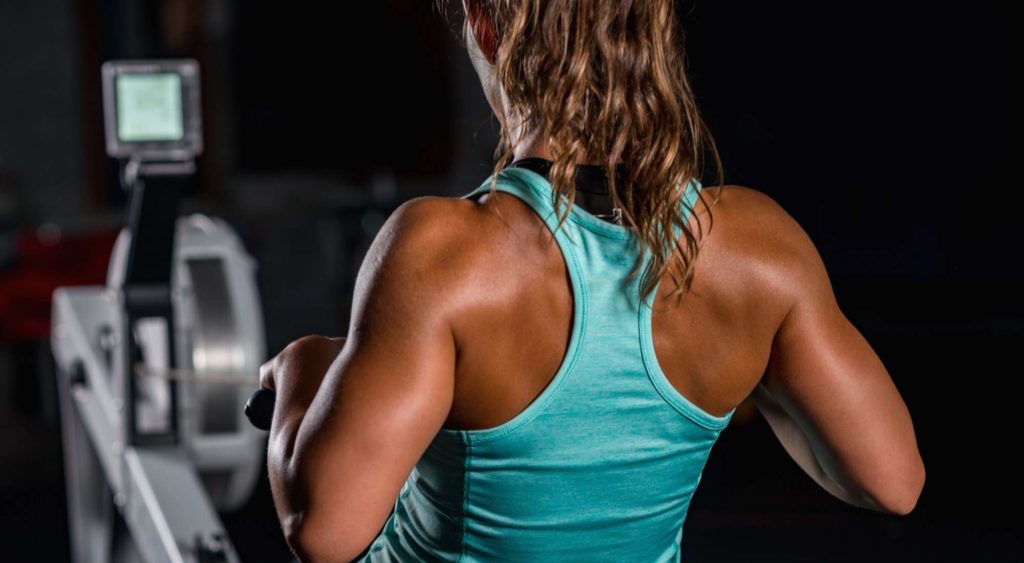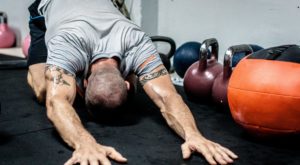
You may have seen rowing machines at your local gym. You may even use them regularly.
What if there were alternatives to get a great strength workout?
What if you could do these exercises anywhere and without an expensive, bulky rowing machine?
Or maybe you’ve simply found yourself asking, “What muscles does a rowing machine work? Is it beneficial to use?” you’ve come to the right place.
Read on to learn about:
- What muscles are targeted with rowing machines
- The pros and cons of using a rowing machine (also called an indoor rower)
- Alternatives to a rowing machine and why they may be a better option
After all, if you’re going to invest your time in exercising, don’t you want to ensure you’re spending that time effectively?
Contents
- What Does a Rowing Machine Work? The Muscles Used in Rowing Change During Each Step of the Rowing Movement
- Rowing Machine: Muscles Worked During Step 1: The “Catch”
- Rowing Machine: Muscles Used During Step 2: The “Drive”
- Rowing Machine: Muscles Targeted During Step 3: The “Finish”
- Rowing Machine: Muscles Worked During Step 4: The “Recovery”
- Benefits of Using a Rowing Machine
- Cardiovascular Conditioning
- Low-Impact Activity
- Downsides of Using a Rowing Machine
- Rowing Requires Focus on Technique and Form
- Rowing Machines Are Large and Take Up Significant Space
- Rowing Machines Are Noisy
- Rowing Can Be Tedious
- Alternatives to the Rowing Machine: Muscle Groups Targeted Similarly
- Cardio Band Row Routine
- Wall Lean Shoulder Blade Contractions
- Inverted Row
- Condition Your Rowing Muscle Groups with In Motion O.C.
What Does a Rowing Machine Work? The Muscles Used in Rowing Change During Each Step of the Rowing Movement
If you’ve ever hopped onto a rowing machine and started rowing without any instruction, there’s a good chance you’re making some mistakes.
Four different steps make up each rowing stroke and different muscles are used as you work through each of the steps.
What muscles does a rower work?
Some call rowing a full-body workout. From a strength perspective, rowing focuses primarily on the back muscles, but you’ll notice the arms, legs, and core activate as well.
Rowing Machine: Muscles Worked During Step 1: The “Catch”
If you’re in a boat, the catch is when the oar blade is placed into the water.
On the rowing machine, the “catch” is the beginning of your stroke. Your:
- Knees are bent
- Shins are vertical
- Arms are straight
- Body is leaning slightly forward
The “catch” is widely considered the most important step during rowing.
During the catch portion of the rowing machine exercise, muscles worked include:
Rowing Machine: Muscles Used During Step 2: The “Drive”
The “drive” is the part of the workout that mimics pulling the oars out of the water and propelling the boat forward. During the drive you’ll:
- Push off with your feet until your legs ar
- e almost fully extended
- Use your core and hip hinge to swing your body into an upright position, leaning slightly forward
- As you continue to push through with your legs, move your upper body so that you begin to lean back
- All of this should be done in a fluid, continuous motion
During the “drive” part of the rowing machine exercise, muscles worked involve the:
- Deltoids
- Trapezius
- Upper Back
- Glutes
- Hamstrings
- Quadriceps
- Calves
- Biceps
- Forearms
- Middle Back
- Abdominal
- Latissimus dorsi
Rowing Machine: Muscles Targeted During Step 3: The “Finish”
The “finish” is the final part of the rowing stroke. During this step:
- Your upper body is leaned slightly back
- Your legs are extended,
- You engage your arms, shoulders, and back to pull the handle towards your lower chest/sternum
Muscles worked during the “finish” include:
- Trapezius
- Deltoids
- Biceps
- Forearms
- Latissimus dorsi
- Glutes
- Quadriceps
Rowing Machine: Muscles Worked During Step 4: The “Recovery”
The “recovery” is essentially the first three steps in reverse. During the recovery you’ll:
- Extend your arms out in front of you, keeping them parallel to the ground
- Hinge forward from your hips and then bend your knees using your hamstrings to pull you forward.
- Keep going until you’re back in the initial “catch” position.
Muscles worked during the “recovery” include:
- Trapezius
- Hamstrings
- Calves
- Deltoids
- Triceps
- Forearms
- Abdominals

Benefits of Using a Rowing Machine
The rowing machine has become a staple piece of equipment at gyms all over. That’s because working out with a rowing machine has its advantages.
Cardiovascular Conditioning
Rowing is a cardiovascular workout. A workout on a rowing machine will burn calories and improve your cardio endurance.
Low-Impact Activity
If you’re looking for low-impact cardio activity, a rowing machine might be a better choice than running on a treadmill, for example.
If you have trouble with your knees, hips, or other joints a rowing machine can provide an aerobic workout without constant pounding on your knees and feet.

Downsides of Using a Rowing Machine
Rowing machines aren’t the best workout option for everyone. As with everything, there are some drawbacks worth considering.
Rowing Requires Focus on Technique and Form
Unless you grew up in a rowing crew or learned to row a canoe at summer camp, the rowing machine stroke isn’t necessarily intuitive.
For rowing to be an effective workout, you must use the correct form. If you row haphazardly and without proper instruction, you’re probably wasting your time.
Other exercises provide the same cardio results without the added hassle of such a strong focus on technique and form.
Additionally, if you aren’t using the proper technique, using a rowing machine could lead to back pain or injury.
Rowing Machines Are Large and Take Up Significant Space
If you’re considering purchasing a rowing machine, you need to ask yourself this question: do I have room for it?
The average rowing machine will take up about 36 square feet. Most machines measure about 8 feet long, and 2 feet wide. However, you’ll also need to account for the full extension of your legs and the arms while rowing.
Depending on your situation, this can be a lot of space for one piece of equipment.
Rowing Machines Are Noisy
Depending on the type of rowing machine you use, they can be exceptionally noisy. This can be problematic if you live in a small home or apartment.
Air and water rowers, in particular, make a lot of noise.
Rowing Can Be Tedious
The very nature of rowing is repetition. You complete the same stroke over and over for 20, 30, or more minutes.
Because you’re doing the same thing over, and over, and over… you may find using a rowing machine tough to stick with in the long run.
Alternatives to the Rowing Machine: Muscle Groups Targeted Similarly
Rowing is a combination of cardio and resistance.
However, if you’re looking to do a cardio workout, rowing isn’t the most effective option for you.
Likewise, if you’re looking to strength train, a rowing machine isn’t the best place to start.
Edgar, In Motion O.C.’s Director of Fitness, says:
“I don’t use rowing machines to train muscles. When someone jumps on a rowing machine, their only intention should be a cardiovascular workout. You’re using your back muscles for rowing, but a rowing machine isn’t the most efficient way to train your back.”
Whether you’re looking to enhance your cardiovascular endurance or gain muscle, you can get a great workout without a rowing machine.
The fitness professionals at In Motion O.C. are highly trained in developing workout programs to help you achieve your goals.
Instead of blindly hopping on a rowing machine hoping you’ll develop toned back muscles, book your free consultation with In Motion O.C. and get started on a fitness program armed with guidance and expertise.
With the help of one of our professionals, you’ll learn the following exercises that work the same muscles as a row machine and more to ensure the best (and safest) workout for you.
Cardio Band Row Routine
A cardio band row routine is a great option. And you can do this routine anywhere.
All you need is an exercise resistance band. You can get these bands in varying levels of resistance, depending on the exercise being performed and your current strength.
Exercise bands provide constant resistance throughout the entire range of motion during an exercise, causing less stress on the joints.
This is a great alternative to a rowing machine.
Resistance Rows
- Stand with your feet hip-width apart on the center of a resistance band. Wrap one end around each foot and cross the handles.
- Bend your knees slightly and lean your chest forward slightly, keeping your back straight.
- Keep your core engaged and your back straight as you pull your hands up to your rib cage, squeezing your shoulder blades together at the top.
- Release your arms and repeat.
Squat Row
- Start in a squat position with your feet shoulder-width apart, body weight sitting on your heels, and your lower back flat while holding the band with both arms in front of your body.
- Stand up tall through your heels while pulling both arms to the side of your chest.
- Squat back down placing your weight on your heels and fully extend your arms back out in front of your body.
Superman Lat Pull
- Holding a light resistance band, lie on your stomach with your arms extended overhead, chest and arms lifted off the floor, and palms facing down. This is your starting position.
- Keeping both arms straight, trace a half-circle with your right arm, extending it directly out to the side and down toward your right thigh. Your left arm should remain straight overhead.
- Reverse the move, slowly returning to the starting position.
Wall Lean Shoulder Blade Contractions
- Stand tall with your back against the wall.
- Raise your elbows until your triceps are parallel to the floor with your hands extended in front of your body.
- Walk your heels six inches forward away from the wall, leaving the midsection of your back and the back of your head against the wall.
- Contract your shoulder blades and drive your elbows into the wall, lifting your mid-back and head away from the wall. Your elbows should always remain in contact with the wall.
- Slowly reverse the movement, and repeat.
Inverted Row
This row uses your body weight, as you’re pulling yourself up to the bar.
- Secure a barbell in a Smith machine or power rack at waist height, and lie face-up on the floor beneath it. The bar should be lined up directly over your chest and should not move.
- Grab the bar with an overhand grip that’s slightly wider than shoulder-width, and hang with your arms fully extended. Your body should form a straight line from your head to your heels, which should be hip-width apart.
- Engage your core and pull your chest to the bar as you squeeze your shoulder blades together.
- Pause, and slowly lower yourself back to your starting position.

Condition Your Rowing Muscle Groups with In Motion O.C.
If you want to build your back muscles and strengthen your core, — or any of the targeted row machine muscles without the need for an actual row machine — the fitness coaches at In Motion O.C. can help.
We can design a program that meets your unique needs, efficiently and effectively.
At In Motion O.C., we work hard to create customized programs that benefit your health and wellness without the need for unnecessary machines or equipment that, if used incorrectly, could potentially hurt you instead of help you.
Contact us to schedule your free consultation.



